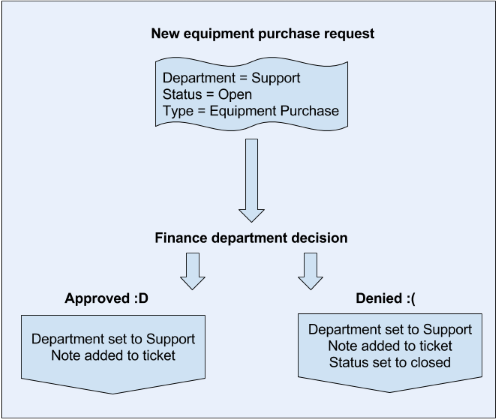Understanding how to use workflows
Let's have a look at a specific example of how a team might use workflows so that we can understand how all the pieces come together. We go with purchasing a piece of new equipment since it is a common use case for workflows.
When a new request comes in where someone wants to purchase a new piece of equipment, what steps does it need to go through?
The request goes through two steps:
- The Support department needs to pass it to the finance team.
- The Finance department either approves or denies the funds for the request.
The flow of the issue would look something like this:

Flow of the issue
Looking at the diagram, we have a few things going on:
- There are two main parties involved – a support team member and a finance team member.
- We have a set of ticket criteria established – open 'equipment purchase' tickets assigned to the support department.
- And we have three total steps defined:
- When the issue comes in, the support staff member uses the workflow to assign the ticket to finance.
- When it lands with finance, they can do one of the following:
approve the request, which returns the issue to support and add a note about their approval,
deny the request, sending it back to support, adding a note, and closing the issue.
In GFI HelpDesk, we can define a workflow for each one of these steps, and limit their visibility based on ticket criteria. Then, every time a purchase request comes in, the support team can move it along to finance with the press of a button, and finance can either approve or deny it.
Now, this example probably is not an exact match for a process in your organization, but you can see how you might start mapping common procedures so they can be standardized with workflows. A great way to get started is to sit down with an actual pen and paper and map out the steps of your real-world processes using flow diagrams. This makes it much easier to determine how many workflows you need and what each of them needs to do.
Read on for step-by-step instructions on how to create a set of workflows that would function as described above.